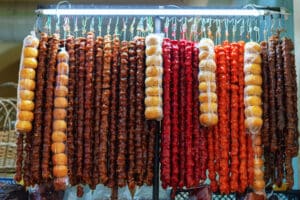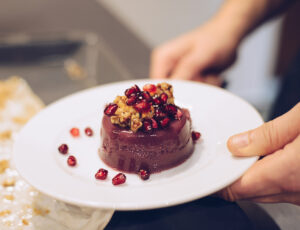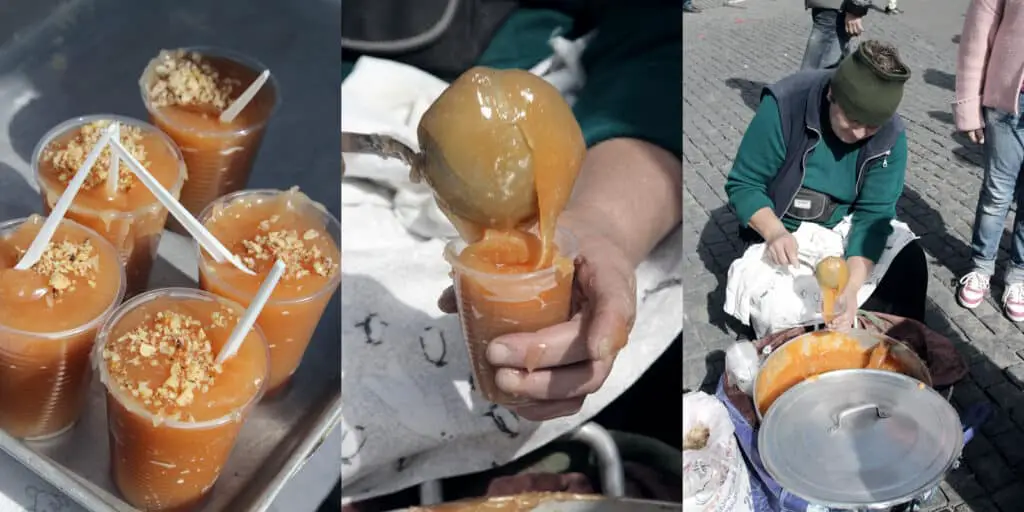Strolling through a marketplace in Georgia, you might be surprised to see the array of multicolored sausage-shaped candies hanging from the stalls. These are churchkhela, a traditional snack made by dipping strings of nuts into thickened fruit juice to create a chewy exterior. In Armenia, you’ll see “sausages” known locally as sharan that are very similar in appearance but, in fact, quite distinctive in taste and texture.
Meanwhile, the thickened fruit juice—known by itself most commonly as pelamushi in Georgia—is also its own treat that you’ll find sold from roadside stands and in local cafes.
Of the three deserts mentioned so far, churchkhela is the most commonly known and we will focus here on its deep connections to Georgian history and culture. However, we will also cover sharan and pelamushi as well as some of the many variations of all three deserts that have arisen in some of the places where they are commonly consumed: Georgia, Armenia, Azerbaijan, Turkey, Iraq, Syria, Iran, Cyprus, Greece, Russia, and Ukraine. As interest in Georgia has grown in recent years, variations of churchkhela are also making their way into fusion cuisines around the world.
Why Are They Called Churchkhela, Sharon, and Pelamushi?
The origins of the word “churchkhela” are debated. Some believe it comes from the words chhur and chkher in Mingrelian, a language spoken in Western Georgia, which translate to “cold” and “hot” respectively. This likely refers to the process of creating churchkhela—the core is coated repeatedly in a hot fruit juice mixture, cooled, and dipped again to build up the candied shell in a process that closely resembles traditional candle making. Others think that the word churchkhela comes from the Georgian root churchkh- which refers to “skeleton.” This would probably refer to the inner hard core fleshed out by the fruit juice. The suffix -ela, incidentally, indicates that the resulting noun is related to the root (something like the “-er” in “gardener.”)
Churchkhela, according to legend, was invented during the time of David the Builder, the great ruler who began what became Georgia’s multi-generational Golden Age. During this time, Georgia’s borders expanded and eventually encompassed much of the Caucasus and even stretched into modern-day Turkey. This included most of modern Armenia and, according to many Armenians, churchkhela actually began as sharan in a village just outside of the Armenian capital of Yerevan. “Sharan” still means “line up” in Armenian.
While there is rivalry between the two bordering cultures, many allow the dispute to be resolved by simply regarding sharan and churchkhela as two separate foods. While they may look very similar, the flavor profile and texture is quite different. Sharan uses cloves, cinnamon, and cardamom while churchkhela gains all its flavor from the grapes and walnuts. Sharan also tends to be softer and stickier.
In other areas, there are other names and variations. For instance, in Greece, which has had cultural and economic relations with Georgian cultures since ancient times, it’s known as soutzoukos, which is typically made from grape must and almonds. The Greek name is also a play off a word for sausage. In Iran and Syria, which have long had substantial Armenian populations, it’s known as baslwq sharh anguwr and jok malbal respectively. In Turkey, where the Georgian empire once had a foothold, it’s cevizli sucuk in Turkish (which translates to “walnut sausage”).
Even inside of Georgia, a small country with profound cultural diversity, there are regional differences. Kakhetian churchkhela typically mixes grape must with wheat flour to create tatara, the thickened mixture in which strung walnuts are then dipped. An Imeretian recipe, meanwhile, uses cornmeal or starch instead of wheat flour to produce what is called pelamushi into which strung hazelnuts or walnuts can be dipped. The hazelnut version is sometimes referred to as janjura to differentiate it and is less common today.
Pelamushi is the more common name for the dessert when sold on its own. This can come in two forms. You might find it served warm and gooey. This is the simplest recipe – and can even be just serving the leftovers from making churchkhela straight from the pot. In another version, the goo is placed into forms and chilled. The result is a fancier, molded dessert with a more jellied consistency. The name has hazy origins, but it should be noted that “pelamushi” is an English version of the Russian version of the name. In Georgian, the dessert is actually “felamushi.”
How to Properly Eat Churchkhela
Most often, churchkhela is sliced with a knife and small disks are set out on a plate to be eaten with tea. You can find this on offer as a light dessert in many restaurants and homes in Georgia. While it is known as the “Georgian Snickers,” you won’t see someone walking and simply munching on a churchkhela bar. They are large, meant to be eaten over time and, above all, shared. It should also go without saying that, no, you don’t eat the string.
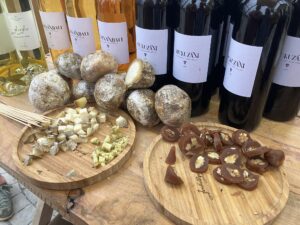
An everyday staple, churchkhela is also associated with Christmas. Children leave churchkhela for “Tovlis Papa,” a character from Georgian folklore who gives gifts to children on Christmas. The sweet is also traditional on tables set for New Year’s Eve and Christmas Day.
One should also keep in mind that churchkhela is representative of the deep roots that viticulture has in Georgian culture. Georgia is one of the world’s oldest winemaking cultures. The grapevine cross is a national symbol of the Georgian Orthodox Church. In good times, raising toasts with wine or chacha (both grape-based drinks) is a national pastime. In bad ones, when Georgians were retreating from invaders, they always carried cuttings from their fields to ensure that they could replant their grapefields someday.
Due to its caloric density and long-lasting nature, Georgian warriors brought churchkhela with them to battles. Churchkhela’s importance was great enough that some monasteries even paid taxes in churchkhela, helping to supply the royal court and army. Alexander the Great was so impressed by its potency that he encouraged his men to carry the snack on his famously long marches and into battle.
How to Properly Cook Churchkhela
While the ingredients used vary depending on the region, Georgians typically use walnuts and grape must thickened with flour or cornstarch. The creation of grape must is also the first step in traditional Georgian wine making. Grape must is what you get when grapes are mashed, often with the feet, and you are left with a slurry of juice, skins, seeds, and stems. Many winemakers will then strain this before putting it away to age. Traditional Georgian wine recipes, however, use straight must and strain only after fermentation. This gives Georgian wines a distinctive and robust flavor.
For churchkhela, the juice is taken from the top, so you are unlikely to find seeds or stems in the finished dessert. If you are making this at home, regular grape juice will do just fine.
Churchkhela can vary widely in color: Georgia has about 400 different grape varieties, ranging from white to red to nearly black. Each of these will impart a unique color and flavor to the churchkhela!
There are also many other regional variations in ingredients. Racha in western Georgia makes a churchkhela with dried fruit, apricots, and pumpkin seeds. In Southern Georgia, churchkhela makers from Samtskhe-Javakheti use mulberry juice in place of grape must. Almonds, hazelnuts, chocolate, and raisins can be added in other variations as well.
Some stores will sell bright green or dark blue churchkhela, made with food dye. Many consider these more exotic variants – and any churchkhela produced outside of Georgia, which often have local flavor profiles – to be inauthentic or at least to be snacks that are not properly called churchkhela. Classic Georgian churchkhela derives its flavor primarily from the grapes and walnuts, often without even added sugar.
Once prepared, churchkhela is hung to dry for at least a few days.
Georgian churchkhela is best around autumn—when grapes and walnuts are freshest—but churchkhela can be made and consumed at any time of the year! It can also be stored for months without going bad. Churchkhela will get harder as it ages, but typically will not mold as long as it’s kept dry.
Let’s Cook Churchkhela, Sharan, and Pelamushi!
Below are some sample recipes for the foods described in this article.
Churchkhela from the Kakhetia Region
Ingredients
- ½ cup neutral oil divided
- 1 cup flour divided
- 8 ½ cups 100% fresh grape juice divided
- 2 cups walnut halves
Preparation
- In a large saucepan, heat 1/4 cup of oil over medium heat until simmering. Whisking, add 1/2 cup of flour and cook, whisking constantly, until the roux darkens slightly in color and gives off a lightly toasted smell, about 3-5 minutes.
- Whisking constantly, pour 4 ½ cups grape juice over the roux. The mixture will sizzle and seize as the juice is added but will loosen as more liquid is incorporated. Whisk continuously while incorporating in order to avoid lumps.
- Bring mixture to a boil and reduce heat to low, allowing to simmer, whisking occasionally to break up any lumps and prevent scorching on the bottom, until very thick and reduced by about half.
- While the tatara is cooking, prepare walnut strings. Thread a needle with doubled thread to make a loop at the top and tie a substantial knot at the end of the thread, leaving a few centimeters at the end. String walnut halves until you reach desired length. Traditionally, churchkhela is made with 25 walnut halves, but you can make them any length you choose. I find that 15 walnut halves are the most manageable. Once strung, leave a few centimeters at the top of the string so that the churchkhela can be hung to dry once dipped.
- Once the tatara is cooked and thickened, remove from heat and allow to cool for about five minutes, or until it has thickened more but remains quite viscous.
- Working one at a time, fully submerge walnut strings into the tatara, holding onto the top string and keeping it from the grape juice mixture. Use a spoon to completely cover the walnuts if necessary. Lift string from tatara, allowing excess to drip off for a few seconds (do not shake off the excess) before hanging to dry in a safe place.
- Allow churchkhela to dry for 24 hours before repeating the process, making a second batch of tatara, and dipping one more time.
- Allow churchkhela to hang to dry for at least 48-72 hours. Remove strings by pulling them through the walnuts before consuming. The churchkhela will darken in color slightly as it dries.
Simple Georgian Pelamushi
Ingredients
- 1 cup grape juice
- ⅓ cup corn flour
- (Optional) Couple of walnuts, mint sprigs, other garnish
Preparation
- Heat grape juice in a saucepan over medium heat. Slowly add corn flour and stir constantly until the flour dissolves and the mixture begins to thicken.
- Once the mixture thickens to desired consistency, continue stirring for 30 seconds or less before turning off heat.
- (Optional) Stir in crushed walnuts while mixture is still warm.
- Pour into a container of your choosing and allow the pelamushi to cool and solidify further.
- Tip mixture onto a plate, or spoon into cups, decorate with walnuts and/or fresh mint sprigs. Serve.
Armenian Sharan
Ingredients
- Approx. 50-75 of shelled, whole walnuts
- 2 cups 100% grape juice
- ¼ cup sugar
- “pinch of nutmeg”
- “pinch of cinnamon”
- “pinch of allspice”
- ¾ cup grape molasses
- ⅓ cup flour
- ⅓ cup corn starch
- 1 cup water
Preparation
- Thread a needle with doubled up thread a bit longer than 15 inches. Tie a sturdy knot at the bottom. Using the needle, carefully poke holes through walnuts one at a time and slide them to the bottom of the thread. Repeat until the thread is approximately ¾ covered by the walnuts, and repeat until you have five threads. Tie paper clips to the tops of the threads (the side without the knot).
- In a pot, combine grape juice, sugar, nutmeg, cinnamon, allspice, and grape molasses. Bring the mixture to a simmer.
- In a bowl, combine flour, corn starch, and water. Whisk together.
- Once the grape mixture is simmering, slowly whisk in flour mixture. The combined mixture should have a thick consistency.
- Take one string of walnuts. Holding the string by the paper clip, submerge the walnuts fully in the grape mixture. Make sure that the walnuts are completely coated. Repeat with other strings. Hang walnuts to dry for 3-5 days minimum in a cool, dry place.
Our Favorite Churchkhela Videos
Step-by-step guide to creating churchkhela in your kitchen. Quick and easy, this video is accompanied by a written recipe and the chef describes how she has altered traditional churchkhela recipes to better suit modern day equipment. Note that she calls the fruit juice mixture “tatara” rather than “pelamushi.”
A pelamushi recipe from a Georgian woman. Note that here, the flour is not first cooked in oil (as the video above does for churchkhela) but the juice is simmered and reduced before the cooking process (which the the video above does not do).
Using a video-only format, two women in Azerbaijan show viewers how to create traditional churchkhela by filming their process! The video includes some cute cats as an added bonus.
https://youtu.be/hdKTMHa-vJ4?si=tu1F-2m8nVZx21y2
You Might Also Like

Mariamoba, Svetitskhoveli, and Giorgoba: Holidays that Reflect Georgia’s Soul
Georgia’s three main autumn holidays, Mariamoba, Svetitskhoveli, and Giorgoba, are a great window to experience the soul of the Georgian people. Each of these state holidays represent a different aspect of Georgia’s unique religious tradition which has developed over the last millennia. Celebrations are well attended and important to Georgians. As a way to fully […]

Guide to Food in Adjara
Georgians take pride in their world-renowned culinary achievements. The wide range of dishes offered in Georgian cooking – which include rich, flavorful meat and vegetable based dishes, as well as pastries, dumplings, soups, and unique salads and side dishes means that nearly everyone can find something to love in this cuisine. Food within Georgia itself […]
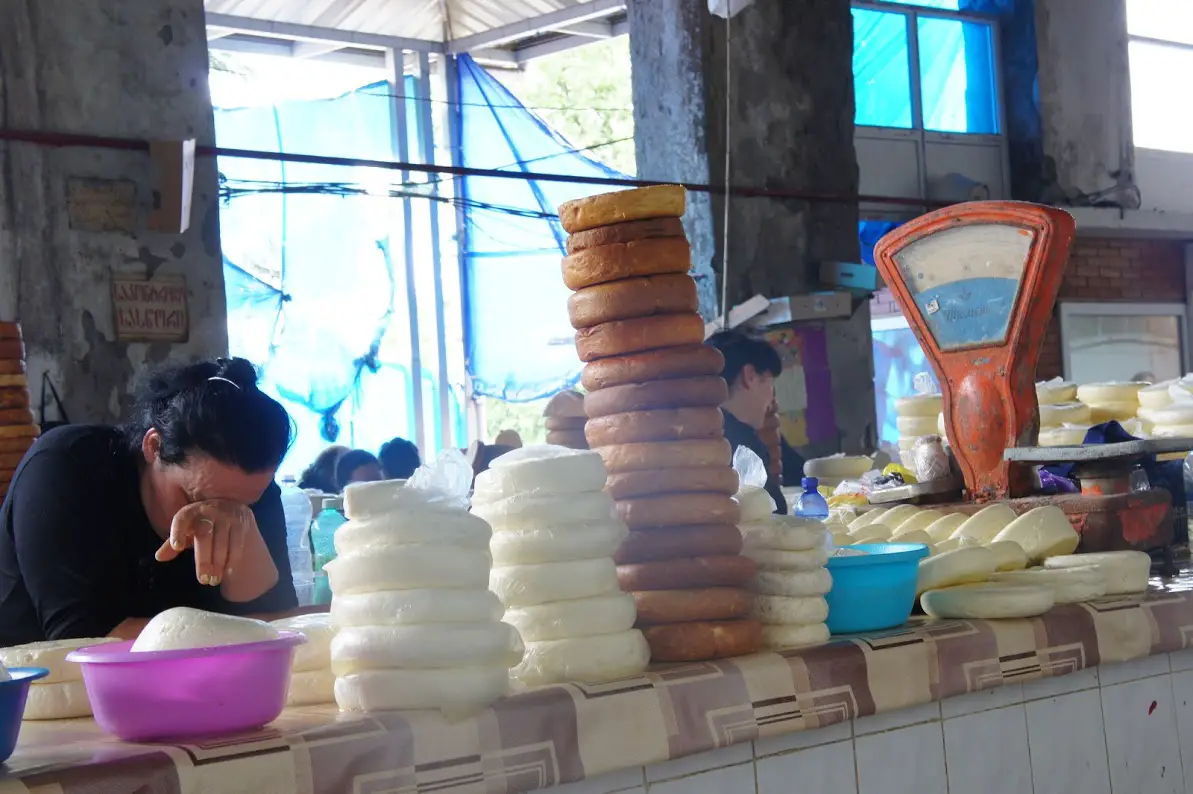
A Guide to Georgian Dairy Products
Georgian cuisine, known for its unique flavor combinations, is also known for several unique dairy products. Like similar dairy products around the world, these originated from the same need to preserve the nutritional and caloric value of milk. With several local twists to the preparation process, however, including the use of “spontaneous starters” – or […]

The Habits of Nuns in Catholic and Orthodox Traditions
Despite their cloistered livelihood, nuns have found their way into many veins of popular theater and movies. However, their usual depiction, wearing black habits with a veil and carrying a rosary, is not accurate for all nuns. It is true that the symbolic meaning of the habit is consistent across both Catholic and Eastern Orthodox […]

Churchkhela, Sharan, and Pelamushi: Desserts Off The Vine
Strolling through a marketplace in Georgia, you might be surprised to see the array of multicolored sausage-shaped candies hanging from the stalls. These are churchkhela, a traditional snack made by dipping strings of nuts into thickened fruit juice to create a chewy exterior. In Armenia, you’ll see “sausages” known locally as sharan that are very […]

